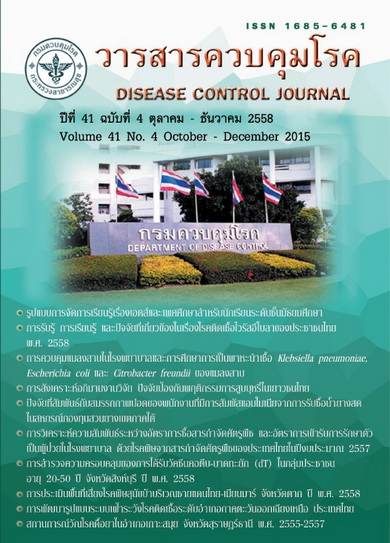Meta synthesis of preventive factors for cigarette smoking among Thai youths
DOI:
https://doi.org/10.14456/dcj.2015.4Keywords:
social ecological model, preventive factors, smoking, Thai youths, meta-synthesisAbstract
Smoking may serve as gateway drug to other substance abuse such as alcohol, heroin, marijuana and methamphetamine. Furthermore, of all the risk factors of ill health, smoking is responsible for the second greatest burden of disease. An understanding of factors affecting smoking among youth is important in protecting them from smoking behaviour. This study, constituting the systematic review and meta-synthesis of literature, aimed to examine factors regarding social ecological model which protect Thai youth from smoking. A comprehensive search of literature in Google Scholar, Scopus and Science Direct was conducted and found 6,372 articles. Eighteen articles fulfilled the selection criteria and quality assessment. The context and findings of the eligible articles were extracted and summarised using social ecological model. The review found that factors in social /policy level, especially tobacco control law and taxation were effective in protecting youth from smoking, factors in the individual level including having a role model (parents, family members, teachers and famous persons) were also the protective factors. In Thailand, there has been policies and implementation which target smoking among youth. However, there was a lack of connections in each level. In addition, intervention in the community level has not corresponded to the factors found in this review. It is recommended that effective youth tobacco control should consider and develop a connection of the complex interplay among various levels.
Downloads
References
2. ศิริวรรณ พิทยรังสฤษฏ์, ปวีณา ปั้นกระจ่าง, กนิษฐา บุญธรรมเจริญ. บทที่ 3 ผลกระทบต่อสุขภาพและเศรษฐกิจจากการบริโภคยาสูบ เปรียบเทียบกับรายได้ทางเศรษฐกิจจากยาสูบ. ใน; ศิริวรรณ พิทยรังสฤษฏ์, ปวีณา ปั้นกระจ่าง, สุนิดา ปรีชาวงษ์, บรรณาธิการ. สรุปสถานการณ์ปัจจัยเสี่ยงหลักด้านยาสูบของประเทศไทย พ.ศ. 2557. กรุงเทพมหานคร: เจริญดีมั่นคงการพิมพ์; 2557. หน้า. 19-21.
3. สุรัตนา พรวิวัฒนชัย. ปัจจัยที่มีอิทธิพลต่อพฤติกรรมการสูบบุหรี่ของวัยรุ่น. กรุงเทพมหานคร: สถาบันวิจัยประชากรและสังคม มหาวิทยาลัยมหิดล; 2553.
4. บุปผา ศิริรัศมี, จรรยา เศรษฐบุตร, ฟิลิป เกสต์, อารีย์ พรมโม้, วรางคณา ผลประเสริฐ, ปรียา เกนโรจน์. ผลกระทบจากนโยบายควบคุมการบริโภคยาสูบในประเทศไทย การสำรวจกลุ่มวัยรุ่นระดับประเทศรอบที่ 1 (พ.ศ. 2548). กรุงเทพมหานคร: สถาบันวิจัยประชากรและสังคม มหาวิทยาลัยมหิดล; 2548.
5. นันทิชา ฦาชา. พฤติกรรมการป้องกันการสูบบุหรี่ของนักเรียนชาย ชั้นมัธยมศึกษาตอนต้น โรงเรียนเบญจมราชานุสรณ์. กรุงเทพมหานคร: มหาวิทยาลัยเกษตรศาสตร์; 2550.
6. ศรีรัช ลอยสมุทร. บทที่ 6 สถานการณ์ผลิตภัณฑ์ยาสูบชนิดใหม่. ใน; ศิริวรรณ พิทยรังสฤษฏ์, ปวีณา ปั้นกระจ่าง, สุนิดา ปรีชาวงษ์, บรรณาธิการ. สรุปสถานการณ์ปัจจัยเสี่ยงหลักด้านยาสูบของประเทศไทย พ.ศ. 2557. กรุงเทพมหานคร: เจริญดีมั่นคงการพิมพ์; 2557. หน้า. 37- 40.
7. สำนักงานสถิติแห่งชาติ. สรุปสำหรับผู้บริหาร การสำรวจพฤติกรรมการสูบบุหรี่และการดื่มสุราของประชากร พ.ศ. 2557 [อินเทอร์เน็ต]. [สืบค้นเมื่อ 12 มิ.ย. 2558]. แหล่งข้อมูล: http://service.nso.go.th/nso/nsopublish/themes/files/smokeExec57.pdf
8. Bronfenbrenner U. The ecology of human development: experiments by nature and design: Cambridge, Massachusetts: Harvard university; 2009.
9. วิโรจน์ เจียมจรัสรังสี, ประศักดิ์ สันติภาพ. การทบทวนองค์ความรู้มาตรการดำเนินการควบคุมและป้องกันโรคหัวใจและหลอดเลือด. กรุงเทพมหานคร: มูลนิธิสาธารณสุขแห่งชาติ; 2547.
10. สมพล วันต๊ะเมล์. แนวทางการป้องกันพฤติกรรมเสี่ยงทางสุขภาพ ตามแนวศึกษานิเวศวิทยาเชิงสังคม [อินเทอร์เน็ต]. [สืบค้นเมื่อ 4 เม.ย. 2558]. แหล่งข้อมูล: www.thaipopulation.org
11. สิทธิพงศ์ วัฒนานนท์สกุล. ผลการใช้โปรแกรมเชิงป้องกันที่มีต่อเจตนาเชิงพฤติกรรมการสูบบุหรี่ในนักเรียนชั้นมัธยมศึกษาตอนต้น [อินเทอร์เน็ต]. [สืบค้นเมื่อ 2 มิ.ย. 2558]. แหล่งข้อมูล: http://ir.swu.ac.th/xmlui/bitstream/handle/123456789/2494/Sittipong_W_R440134.pdf?sequence=1
12. จันทนา คำน้อย. พฤติกรรมป้องกันการสูบบุหรี่ของนักเรียนระดับมัธยมศึกษาตอนปลาย ตำบลแม่อาย อำเภอแม่อาย จังหวัดเชียงใหม่ [วิทยานิพนธ์ปริญญาพยาบาล ศาสตรมหาบัณฑิต]. เชียงใหม่: มหาวิทยาลัยเชียงใหม่; 2551.
13. ศิริธิดา ศรีพิทักษ์, ยุคนธ์ เมืองช้าง, จารุวรรณ สนองญาติ, ลักขณา ศิรถิรกุล, สินีพร ยืนยง. ประสิทธิผลของโปรแกรมป้องกันการสูบบุหรี่ในนักเรียนมัธยมศึกษาตอนต้น จังหวัดสุพรรณบุรี. วารสารวิทยาลัยพยาบาลพระปกเกล้า จันทบุรี 2555;23:38-52.
14. ศิริญญา ชมขุนทด, พรนภา หอมสินธุ์, รุ่งรัตน์ ศรีสุริยเวศน์. ผลของโปรแกรมสร้างเสริมสมรรถนะแห่งตน และการมีส่วนร่วมของครอบครัวต่อความมั่นใจในการหลีกเลี่ยงการสูบบุหรี่ และความตั้งใจไม่สูบบุหรี่ของนักเรียนชั้นประถมศึกษาชาย. วารสารสาธารณสุข มหาวิทยาลัยบูรพา 2557;9:91-103.
15. วรรณชนก จันทชุม. การพัฒนากลวิธีในการป้องกันการสูบบุหรี่ของนักเรียน โดยใช้กระบวนการมีส่วนร่วม : กรณีศึกษาโรงเรียนขยายโอกาสในจังหวัดกาฬสินธุ์.วารสารพฤติกรรมศาสตร์ 2549;12:94-109.
16. กมลภู ถนอมสัตย์, รัชนี สรรเสริญ. ปัจจัยที่สัมพันธ์กับการสูบบุหรี่ในระยะเริ่มต้นของนักเรียนชายชั้นมัธยมศึกษาตอนต้น สังกัดสำนักงานเขตพื้นที่การศึกษาตราด. วารสารการพยาบาลและการศึกษา 2554;4:38-47.
17. โชคชัย สาครพานิช. ปัจจัยที่สัมพันธ์กับการตั้งใจสูบบุหรี่ของนักเรียนชายที่ไม่สูบบุหรี่ ชั้นมัธยมศึกษาตอนปลาย โรงเรียนเขาสมิงวิทยาคม จังหวัดตราด. วารสารศูนย์การศึกษาแพทยศาสตร์คลินิก โรงพยาบาลพระปกเกล้า 2554;28:44-52.
18. จักรพันธ์ เพ็ชรภูมิ, ณรงค์ศักดิ์ สอนหนู, ปิยะรัตน์ นิ่มพิทักษ์พงศ์, ศันสนีย์ เมฆรุ่งเรื่องวงศ์. ปรากฏการณ์แบบแผนและภาพจำลองทางความคิดของพฤติกรรมการจำหน่ายผลิตภัณฑ์ยาสูบให้เยาวชนของผู้ประกอบการร้านค้าปลีกในชุมชนชนบท. วารสารพฤติกรรมศาสตร์ 2558;21:39-59.
19. สุวรรณี จรูงจิตรอารี, นวลอนงค์ ชัยปิยะพร, สลิลา เศรษฐไกรกุล, อโนมา สันติวรกุล. ปัจจัยที่มีผลต่อการสูบบุหรี่ของนักศึกษาอาชีวศึกษาในเขตกรุงเทพมหานคร. วารสารเทคนิคการแพทย์และกายภาพบำบัด 2556;25:164-71.
20. Dumrongpiwat S, Wongwiwatthananukit S, Krittiyanunt S, Khlaisang M, Suwanmajo S. Tobacco smoking behavior in youth. J Health Res 2009; 23:103-9.
21. Chutima Deesawat, Chaweewon Boonshuyar, Lukkhana Termsirikulchai. A Multilevel study of smoking among youths in school at Buriram Province. J Med Assoc Thai 2012;95:S78-86.
22. Miller BA, Byrnes HF, Cupp PK, Chamratrithirong A, Rhucharoenpornpanich O, Fongkaew W, et al. Thai parenting practices, family rituals and risky adolescent behaviors: alcohol use, cigarette use and delinquency. International journal of child and adolescent health 2011;4:367.
23. Sirirassamee T, Sirirassamee B, Jampaklay A, Borland R, Fong GT. Risk factors of tobacco use among Thai adolescents: finding from international tobacco control policy survey southeast Asia (ICT-SEA). J Med Assoc Thai 2009; 92:S4-8.
24. Page RM, Suwanteerangkul J, Sloan A, Kironde J, West J. Thai adolescents’ normative beliefs of the popularity of smoking among peers, adults, the successful and elite, and parents. Social Development 2012;21:849-67.
25. Lee G, Lee J, Lee S. Risk factors of future smoking among Thai youth : a secondary analysis of the Thai Global Youth Tobacco Survey. Asia-Pacific Journal of Public Health 2015;27:2602-9.
26. Chaikoolvatana A, Manwong M, Junnual N, Chaikoolvatana C, Thongnun W, Apirakmontree J, et al. Effects of a cigarette smoking prevention program among junior high school students in north-east Thailand: a pilot survey. J Med Assoc Thai 2013;96:730-41.
27. Sirichotiratana N, Techatraisakdi C, Rahman K, Warren CW, Jones NR, Asma S, et al. Prevalence of smoking and other smoking-related behaviors reported by the Global Youth Tobacco Survey (GYTS) in Thailand. BMC Public Health 2008;8:1-7.
28. Seal N. Preventing tobacco and drug use among Thai high school students through life skills training. Nursing & Health Sciences 2006;8:164-8.
Downloads
Published
How to Cite
Issue
Section
License
Articles published in the Disease Control Journal are considered as academic work, research or analysis of the personal opinion of the authors, not the opinion of the Thailand Department of Disease Control or editorial team. The authors must be responsible for their articles.


.png)



